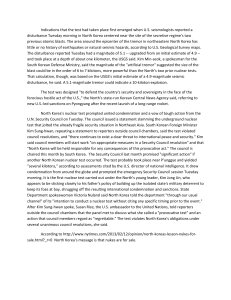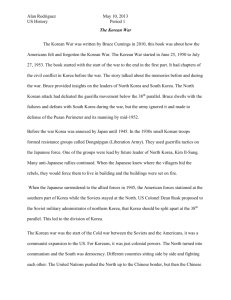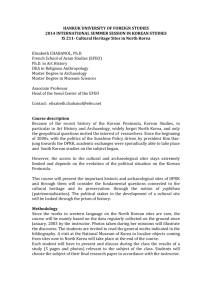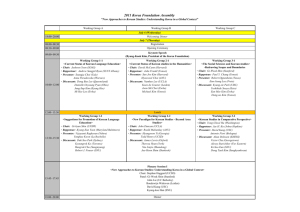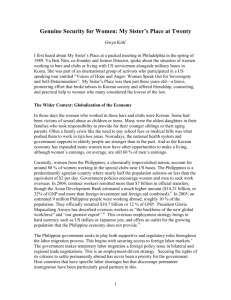Partnering With South Korea for Progress
advertisement
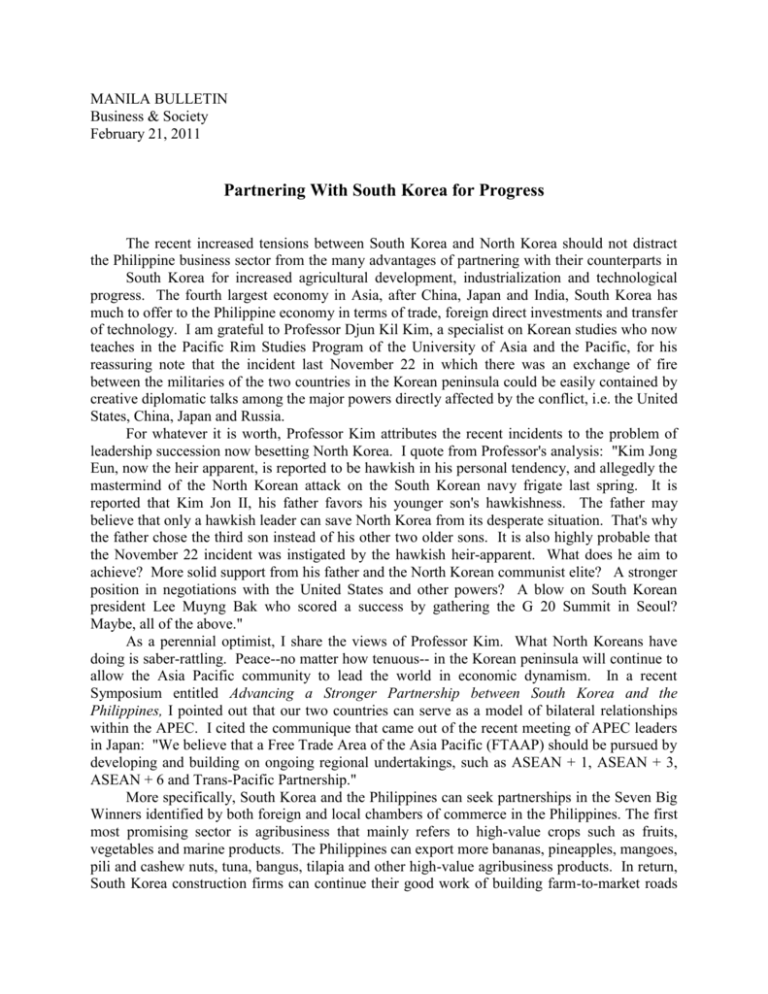
MANILA BULLETIN Business & Society February 21, 2011 Partnering With South Korea for Progress The recent increased tensions between South Korea and North Korea should not distract the Philippine business sector from the many advantages of partnering with their counterparts in South Korea for increased agricultural development, industrialization and technological progress. The fourth largest economy in Asia, after China, Japan and India, South Korea has much to offer to the Philippine economy in terms of trade, foreign direct investments and transfer of technology. I am grateful to Professor Djun Kil Kim, a specialist on Korean studies who now teaches in the Pacific Rim Studies Program of the University of Asia and the Pacific, for his reassuring note that the incident last November 22 in which there was an exchange of fire between the militaries of the two countries in the Korean peninsula could be easily contained by creative diplomatic talks among the major powers directly affected by the conflict, i.e. the United States, China, Japan and Russia. For whatever it is worth, Professor Kim attributes the recent incidents to the problem of leadership succession now besetting North Korea. I quote from Professor's analysis: "Kim Jong Eun, now the heir apparent, is reported to be hawkish in his personal tendency, and allegedly the mastermind of the North Korean attack on the South Korean navy frigate last spring. It is reported that Kim Jon II, his father favors his younger son's hawkishness. The father may believe that only a hawkish leader can save North Korea from its desperate situation. That's why the father chose the third son instead of his other two older sons. It is also highly probable that the November 22 incident was instigated by the hawkish heir-apparent. What does he aim to achieve? More solid support from his father and the North Korean communist elite? A stronger position in negotiations with the United States and other powers? A blow on South Korean president Lee Muyng Bak who scored a success by gathering the G 20 Summit in Seoul? Maybe, all of the above." As a perennial optimist, I share the views of Professor Kim. What North Koreans have doing is saber-rattling. Peace--no matter how tenuous-- in the Korean peninsula will continue to allow the Asia Pacific community to lead the world in economic dynamism. In a recent Symposium entitled Advancing a Stronger Partnership between South Korea and the Philippines, I pointed out that our two countries can serve as a model of bilateral relationships within the APEC. I cited the communique that came out of the recent meeting of APEC leaders in Japan: "We believe that a Free Trade Area of the Asia Pacific (FTAAP) should be pursued by developing and building on ongoing regional undertakings, such as ASEAN + 1, ASEAN + 3, ASEAN + 6 and Trans-Pacific Partnership." More specifically, South Korea and the Philippines can seek partnerships in the Seven Big Winners identified by both foreign and local chambers of commerce in the Philippines. The first most promising sector is agribusiness that mainly refers to high-value crops such as fruits, vegetables and marine products. The Philippines can export more bananas, pineapples, mangoes, pili and cashew nuts, tuna, bangus, tilapia and other high-value agribusiness products. In return, South Korea construction firms can continue their good work of building farm-to-market roads 2 (some of the most long-lasting roads constructed during the Marcos regime were those by Korean firms, such as Hanil), irrigations systems and post-harvest facilities. In fact, through Korean development aid, the province of Aurora has been endowed with palay driers and other agricultural infrastructures. We can also benefit from intermediate technology in farm machinery that helped the Korean farmers become more productive through the use of small tractors and threshers (such as those produced by the company Daedung Agricultural Machinery). Much can also be learned from South Korea in the organization of rural cooperatives through the famous Saemaul Undung movement popularized during the presidency of Park Chung Hee. Professor Kim cited above, in fact, is undertaking an ADB-sponsored research on how the Saemaul Undung can be adapted to the Philippines and other Southeast Asian countries. Besides roads and bridges, South Korean investors can help develop an efficient train system in the larger islands of Luzon, Mindanao and Panay. Some of the most efficient train systems are now in South Korea. In recent trips to Seoul and the surrounding urban areas, I was impressed with the bullet train technology that the Koreans have developed over the last ten years, equaling, if not surpassing North America and Europe. Energy is another area in which South Korea has much to contribute to the Philippines. The Korean Electric Power Company (KEPCO) is already heavily invested in the Philippines. Who knows, one day it may be the energy company that will build for us with our first nuclear power plant somewhere in the island of Mindanao, whose overdependence on hydroelectric power does not bode well for its future economic progress. Korean and Philippine enterprises can also partner to invest in the enormous possibilities of renewable energy in the Philippines. For comments, my email address is bvillegas@uap.edu.ph.





